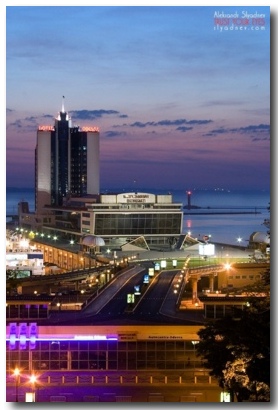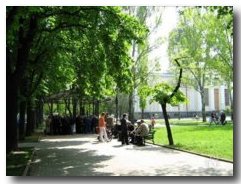The ancient Greek colony occupied the site of Odessa from the first settlements till the end of 19th century. A link between eastern Mediterranean and the area of Odessa has been confirmed by archeological artifacts. The Kievan Rus, The Golden Horde, the Gran Duchy of Lithuania, the Crimean Khanate and the Ottoman Empire ruled the Odessa region in succession throughout the Middle Ages and in 14th century, Yedisan Tatars were recorded trading commerce. Russia then acquired these lands at the end of 18th century during the Russo-Turkish wars. The Khanate were endangered by the Golden Horde and Ottoman Turks during the times of Khan Haci I Giray resulting in the khans agreeing to cede to the Grand Duchy of Lithuania. Nowadays, the area of Odessa was known before as Khadjibey and was a section of the Dykra region. At that time though, most of the place was desolate.

In 1895, the church of the monastery of St Pantelimon was consecrated and used as a planeetarium from 1961-1991. When the Khdjibey was controlled by the Ottoman Turks Empire in 1529, it became part of the region called Yedisan and it was under the Ottoman Silistra Province. The Ottomans then restructure a frotress at Khadjibey in the mid 18th century and it was called Yeni Dunya.
In September 1789 during the Russo-Turkish War, Major General Jose de Ribas also called in Russia as Osip Mikhalovich Deribas was the commander of a Russian service and the Deribasovskaya Street was named after him which has become the main street of Odessa. In 1972 Odessa became part of the so called Novorossiya meaning “New Russia.”
In 1974, the area become the official naval fortress for the Russians but was renamed Odessa in January 1795 as seen in official correspondence. The reason why it was renamed is still unknown until today though many have ideas but not it has never formally relayed on writings. One of this hearsays is that Catherine II did not want another masculine name in the South of the Empire and when Odessos was suggested, she changed it to Odessa instead to make it feminine.
This tell tale seems to be absurd as there were known two cities Theodosia and Eupatoria and they were feminine in terms of names. Another hearsay is that the word Odessa was derived from the word-play which was in French: assez d’eau meaning “plenty of water.” And if it is pronounced backward, it is quite similar to that of the Greek name. This fit very well as Odessa was actually near the sea although there were limited supply of fresh water. This hearsay might be the origin as it is logical in its origin but no one can confirm it to date.
In 1803 to 1814, Dyc de Richeliuw was the governor and under his regime, the city has grew sucesfully. Duc de Richelieu fled the French Revolution and had served under Chaterene’s army in fighting the Turks. He was responsible for the infrastructure and design of the magnificent city of Odessa and was considered one of the founders hence the institution of his famous bronze statue commemorated by Count Alexandre Andrault de Langeron, his successor in 1828. The famous statue was designed by Ivan Martos.
The city became a free port which was maintained from 1819 to 1859. The Greeks, Bulgarians, Albanians, Russians, Jews, Romaninas, Italian, Frenchmen, Germans and traders of many other nations populated the city and became a melting pot together with the Ukrainians hence the city upgraded itself to the heights of cosmopolitan stature. This was recorded by the great poet Alexander Pushkin, who himself is an external exile in Odessa from 1823-1824. He further wrote that you can smell Europe in the city of Odessa
The Crimean War of 1853-1856 disturbed the growing city of Odessa where the British and French naval forces deployed its bombs on that period. The aftermath brought forth further growth in trade and Odessa became Russia’s biggest port for grain export. Odessa was then connected by rail in 1866 with Kharkiv and Kiev and also towards Iasi, Romania.
In 19th century, Odessa was populated by Jewish community and in 1897, statistics showed a 37 percentile of the population were Jews. It is to be noted however that they were persecuted in many occasions as history reveals to us where pogroms were executed in 1821, 1859, 1871, as well as in 1905. Palestine was the refuge of some Odessan Jews while some to different cities abroad.
The worker’s uprising with the support by the crew of the Russian battleship Potemkin and Lenin’s Iskra marked the first half of the 20th century. This was even popularized by the movie of Sergei Eisenstein called “The Battleship Potemkin” in 1925. The movie depicted the uprising and showed many Odessan citizens murdered on the stone staircase now famous as the “Potemkin Steps.” Actually, the massacre happened in the streets nearby and not on the famous steps. However, the movie created an interest in many guest to visit the popularized slaughter site. The movie was made in its local soil and it is one of the oldest cinema studio in the USSR.
In February 1920, Bolshevik forces entered Odessa. The city was occupied by the Ukrainian Tsentral’na, the Red Army, the French Army and the White Army. In 1920, Odessa was taken over by the Red Army and unified it with the Ukrainian SSR and later became under the USSR.

A famine occurred in 1921 to 1922 due to civil war and in 1941, The Red Army destroyed the harbour facilities.
The second half of the 20th century marked the immediate recovery of Odessa, with the new migrants bringing industrial professionals from all over the Soviet. The ingenuity of its people and its geographical position tends to be the major cause of easy recovery for Odessa.
The collapse of communism in 1991 gave independence to Ukraine and the city became part of that historical event. The industries like oil refining, shipbuilding, chemicals, food processing and other national economic dragon pushers continued to elevate the growth of Odessa until today. Odessa’s naval base and fishing fleets also boast Ukrainian to international market and Ukraine became known to many as simply Odessa.